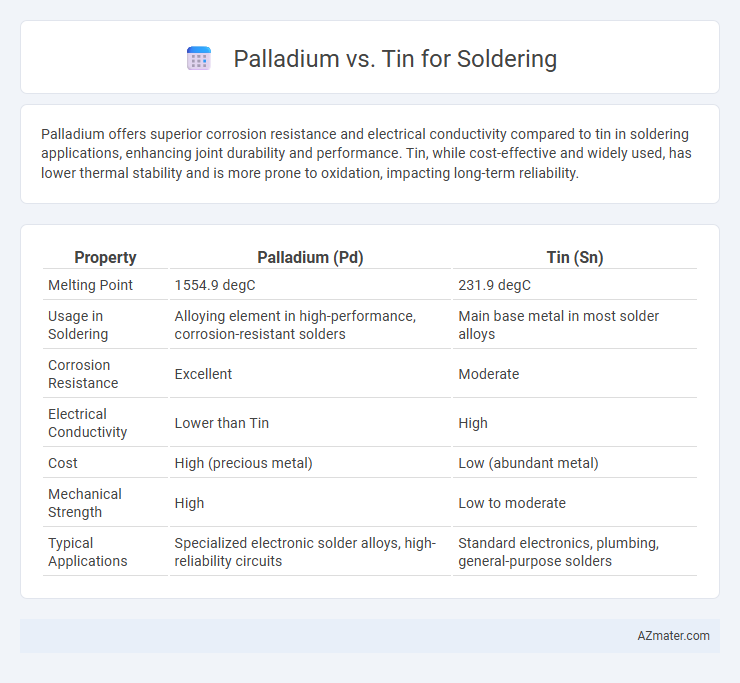Palladium offers superior corrosion resistance and electrical conductivity compared to tin in soldering applications, enhancing joint durability and performance. Tin, while cost-effective and widely used, has lower thermal stability and is more prone to oxidation, impacting long-term reliability.
Table of Comparison
| Property | Palladium (Pd) | Tin (Sn) |
|---|---|---|
| Melting Point | 1554.9 degC | 231.9 degC |
| Usage in Soldering | Alloying element in high-performance, corrosion-resistant solders | Main base metal in most solder alloys |
| Corrosion Resistance | Excellent | Moderate |
| Electrical Conductivity | Lower than Tin | High |
| Cost | High (precious metal) | Low (abundant metal) |
| Mechanical Strength | High | Low to moderate |
| Typical Applications | Specialized electronic solder alloys, high-reliability circuits | Standard electronics, plumbing, general-purpose solders |
Introduction to Palladium and Tin in Soldering
Palladium and tin are essential metals used in soldering, each offering distinct properties for electronic assembly and metal joining applications. Palladium, a rare and corrosion-resistant noble metal, is prized for its excellent wetting ability and strong, reliable joints in high-performance and lead-free soldering processes. Tin, a more abundant and cost-effective metal, provides good conductivity and adhesion, commonly alloyed with lead or silver to enhance mechanical strength and melting characteristics in a wide range of solder formulations.
Material Properties: Palladium vs Tin
Palladium exhibits exceptional oxidation resistance and excellent mechanical strength, making it ideal for high-reliability soldering applications. Tin offers superior wettability and lower melting points, which facilitates easy soldering and strong joint formation but is prone to oxidation and whisker growth. The choice between palladium and tin depends on balancing corrosion resistance, thermal stability, and cost-efficiency in electronic assembly processes.
Melting Point Comparison
Palladium has a melting point of approximately 1,555degC, significantly higher than tin's melting point of 232degC, which influences their performance in soldering applications. Tin's low melting point allows for easy melting and solidification during soldering, making it ideal for delicate electronic components. In contrast, palladium's high melting point provides excellent thermal stability but requires much higher temperatures, limiting its use primarily to alloys or specialized soldering processes.
Electrical Conductivity Differences
Palladium exhibits superior electrical conductivity compared to tin, making it a preferred choice in high-performance soldering applications where minimal resistance is critical. Tin's conductivity typically ranges around 9.17 x 10^6 S/m, whereas palladium offers approximately 9.5 x 10^6 S/m, enhancing signal integrity and reducing power loss. This difference in conductivity directly impacts the efficiency and reliability of electronic connections in advanced circuitry.
Oxidation and Corrosion Resistance
Palladium solder alloys exhibit superior oxidation resistance due to their excellent stability at elevated temperatures, reducing solder joint degradation during reflow processes. Tin-based solders, while widely used, are more prone to oxidation and surface contamination, which can compromise solder joint reliability over time. Corrosion resistance in palladium-enhanced solders extends the lifespan of electronic components by minimizing the formation of intermetallic compounds and maintaining strong mechanical and electrical connections.
Solder Joint Reliability and Durability
Palladium-based solder offers superior joint reliability and durability due to its excellent corrosion resistance and stable metallurgical bonds, making it ideal for high-performance electronics and harsh environments. Tin, commonly used in solder alloys like SnPb or SnAgCu, provides good conductivity and wetting properties but can suffer from issues such as tin whiskers and thermal fatigue over time, potentially compromising joint integrity. The choice between palladium and tin hinges on application-specific demands, with palladium preferred for critical, long-lasting connections and tin favored for cost-effective, general-purpose soldering.
Cost and Availability Considerations
Palladium soldering materials generally command higher costs due to the metal's rarity and significant industrial demand, making them less economical compared to tin-based solders. Tin solder alloys are widely available and produced at scale, ensuring lower prices and easy procurement in the electronics industry. The cost-effectiveness and abundant supply of tin make it the preferred choice for mass-market soldering applications despite palladium's superior corrosion resistance and thermal stability.
Common Applications in Electronics
Palladium solder is widely used in high-reliability electronics such as aerospace and medical devices due to its excellent joint strength and corrosion resistance. Tin solder remains the industry standard for consumer electronics and PCB assembly because of its affordability, ease of use, and good electrical conductivity. Both materials play crucial roles depending on performance requirements and environmental conditions in electronic manufacturing.
Environmental and Safety Impacts
Palladium soldering alloys offer lower toxicity and reduced environmental hazards compared to tin-based solders, which can release harmful lead or other heavy metals during melting. Palladium's resistance to oxidation and corrosion minimizes waste and the need for flux chemicals, decreasing environmental contamination. Tin solder, while widely used, poses risks due to potential lead content and the generation of toxic fumes, requiring careful ventilation and safe disposal protocols.
Choosing the Right Material for Your Project
Choosing between palladium and tin for soldering depends on the specific requirements of your project, such as conductivity, corrosion resistance, and melting point. Palladium offers excellent oxidation resistance and durability, making it ideal for high-reliability electronics and harsh environments, while tin is more cost-effective and widely used for general-purpose soldering with moderate corrosion resistance. Consider the application's electrical performance needs, mechanical strength, and budget constraints to select the optimal solder material.

Infographic: Palladium vs Tin for Soldering
 azmater.com
azmater.com